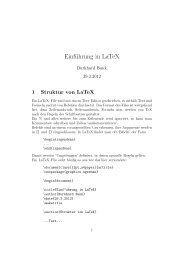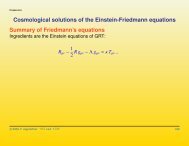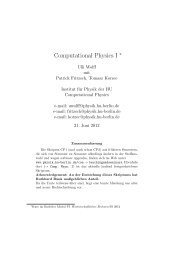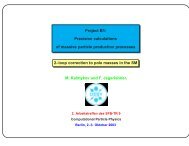Preprint[pdf] - HU Berlin
Preprint[pdf] - HU Berlin
Preprint[pdf] - HU Berlin
Create successful ePaper yourself
Turn your PDF publications into a flip-book with our unique Google optimized e-Paper software.
➪<br />
µ + νµ L<br />
➪<br />
↕ P<br />
π +<br />
✘<br />
➪<br />
µ + νµ R<br />
➪ π+<br />
CP<br />
↔<br />
տ ր<br />
ւ ց<br />
C<br />
CP<br />
↔<br />
➪<br />
π −<br />
➪<br />
µ − ¯νµ R<br />
➪<br />
↕ P<br />
✘<br />
µ − ¯νµ L<br />
Fig. 1. In the P violating weak pion decays leptons of definite handedness are produced depending on the given charge. µ − [µ + ]<br />
is produced with positive [negative] helicity h = � S · �p/|�p|. The physical µ − and µ + decays are related by a CP transformation.<br />
The decays obtained by C or P alone are inexistent.<br />
The pion decay rate is given by<br />
Γ π − →µ − ¯νµ = G2 µ<br />
8π |Vud| 2 F 2 π mπ m 2 µ<br />
with δQED the electromagnetic correction.<br />
�<br />
1 − m2 µ<br />
m 2 π<br />
2) Muon decay:<br />
The muon is unstable and decays via the weak three body decay µ − → e − ¯νeνµ<br />
µ −<br />
W −<br />
� 2<br />
➪ π−<br />
× (1 + δQED) , (11)<br />
νµ<br />
e− ¯νe<br />
µ–decay<br />
The µ–decay matrix element follows from the relevant part of the effective Lagrangian which reads<br />
Leff,int = − Gµ<br />
√2 (ēγ α (1 − γ5) νe)(¯νµγα (1 − γ5) µ) + h.c.<br />
and is given by<br />
T = out< e − , ¯νeνµ|µ − >in= Gµ<br />
√2 (ūeγ α (1 − γ5) vνe) � �<br />
ūνµγα (1 − γ5) uµ .<br />
This proves that the µ − and the e − have both the same left–handed helicity [the corresponding anti–particles<br />
are right–handed] in the massless approximation. This implies the decay scheme of Fig. 2 for the muon. Again<br />
¯νµ R<br />
νe L<br />
➪<br />
➪<br />
µ +<br />
➪<br />
➪<br />
e +<br />
Fig. 2. In µ − [µ + ] decay the produced e − [e + ] has negative [positive] helicity, respectively.<br />
it is the P violation which prefers electrons emitted in the direction of the muon spin. Therefore, measuring<br />
the direction of the electron momentum provides the direction of the muon spin. After integrating out the<br />
two unobservable neutrinos, the differential decay probability to find an e ± with reduced energy between xe<br />
and xe + dxe, emitted at an angle between θ and θ + dθ, reads<br />
d 2 Γ ±<br />
dxe d cosθ = G2 µm 5 µ<br />
νµ L<br />
¯νe R<br />
·<br />
192π 3 x2 e (3 − 2xe ± Pµ cosθ (2xe − 1)) (12)<br />
10<br />
➪➪ ➪ ➪<br />
µ −<br />
e −


![Preprint[pdf] - HU Berlin](https://img.yumpu.com/3833433/10/500x640/preprintpdf-hu-berlin.jpg)




